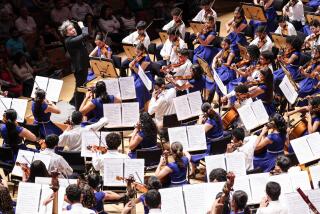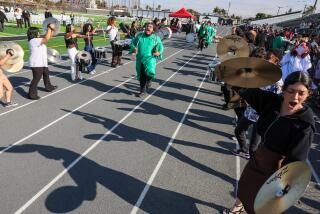The Classical Curriculum : Orchestras are making a comeback at local schools. But after graduation, there are few opportunities to play.
Every morning at Anacapa Middle School, a group of students gathers in the school band room to play melodies by Beethoven, Haydn and Schubert on the violin, cello and string bass.
They are playing some of Western culture’s oldest instruments to give life to music from some of the most popular classical composers.
But they are making sounds rarely heard these days on Ventura County campuses.
In sharp contrast to 25 years ago, when many Ventura County schools had thriving string-music programs, Anacapa Middle School is one of only a few schools in the county that still has an orchestra.
But after a long period of school orchestras falling silent, string-music instruction at local public schools is beginning to rise toward a small crescendo.
In Ventura, the Anacapa orchestra has grown by more than a third since 1990. Balboa Middle School has restarted an orchestra class that it canceled in the 1980s. And Buena High School will try to revive its orchestra next spring with a small group that will meet after school.
Across the county in Simi Valley, the Sequoia Junior High School orchestra has stabilized at about 25 players, after having only one member 15 years ago.
And the Simi Valley High School orchestra, the only high school orchestra in the county, continues to win superior ratings at band festivals even though it has only a dozen members.
Last year, the Conejo Valley Unified School District began to offer string-music instruction at a handful of elementary schools. When this first crop of young string players reaches high school in a few years, music teachers hope to launch the district’s first high school orchestra at Thousand Oaks High.
The rebirth of interest in school orchestras mirrors a trend across Southern California, music educators said, that may signal a renewed appreciation of the value of teaching the arts.
“There is certainly a rebound,” said John Vorwald, president of the Southern California School Band and Orchestra Assn. “I think most districts realize that the arts are very important.”
Ed Francis, a private music teacher who is working with the Ventura County Symphony Orchestra to revive school music programs, has also noticed a change in attitude toward teaching music in schools.
“Parents and the community are finally realizing that it was a tremendous mistake to cut these programs out because the arts are important,” he said.
*
In Ventura County, the cuts began in the early 1970s, when school districts from Camarillo to Simi Valley began eliminating music programs at their elementary schools. And the cuts intensified during the school budget crisis that followed the 1978 Proposition 13 tax revolt.
The cutbacks at the elementary level were eventually felt at many local high schools, which were drawing too few string players to maintain orchestras.
By the early 1980s, for example, the orchestras at all five high schools in the Oxnard Union High School District had folded.
But at the same time districts took their budget axes to their orchestral programs, they usually spared their high school marching bands.
Marching bands appear at school football games and community parades, making them much more visible to parents, students and to the school officials who make budget decisions.
“The marching band has become a huge part of most high school programs,” Sequoia Junior High School music teacher Corey Nordal said. “It’s a public relations tool for any school.”
But students lose a great deal by not having a school orchestra, music educators said, even if the pupils don’t know what they’re missing.
For student musicians, string orchestras are often their only opportunity to perform the original works of the great classical composers.
“Orchestral music is really the foundation of all serious music,” Vorwald said. “The wealth of classical music, music that has stood the test of time, is basically from that medium.”
And for students who don’t play string instruments, school orchestras offer a chance to learn to appreciate classical music.
Only by exposing young people to such music, Vorwald said, can society reverse the trend of shrinking audiences for professional orchestras.
“If you don’t expose the school population to orchestras,” he said, “how are they going to know what orchestras sound like?”
But over the past 10 to 20 years, most students in Ventura County have not been getting such exposure.
*
Although Thousand Oaks and Camarillo schools have both started offering limited classes in strings over the past two years, the only orchestras besides Simi Valley High School are at Sequoia Junior High School in Simi Valley and Anacapa and Balboa middle schools in Ventura.
Most of these programs are, however, thriving.
Anacapa’s orchestra has grown from about 36 students four years ago to nearly 50. Balboa will have more than 40 students playing strings next year. And the size of the Sequoia orchestra is stable at around 25 students, after fluctuating for many years.
“It has stabilized to the point that I’m over my fear every year of losing my orchestra because there’s not enough kids,” Nordal said.
But once student string players graduate from middle and junior high schools, they have few opportunities to continue playing.
Only students at Sequoia are lucky enough to be able to move on to a high school orchestra.
In other parts of the county, young string players are able to join the Ventura County Youth Symphony and the Conejo Youth Symphony. But both of these groups practice far less than the daily classes held at schools.
“It’s better to work every day in school,” said 13-year-old Carlos Renteria, who plays violin in the Anacapa orchestra.
When Carlos graduates from Anacapa, he will attend Buena High, which plans to launch its pilot orchestral program next year. But the outcome of that project and of the plan to eventually launch an orchestra at Thousand Oaks High School will depend on whether the orchestra classes draw enough students.
And that may be a problem.
Because many high schools have boosted the number of required courses and cut the number of periods free for electives, students who want to squeeze in extra, college-prep classes often have little time available for music classes.
At Simi Valley High, the orchestra has not grown beyond about a dozen students each year.
Michelle Scarrott, a 17-year-old cellist at Simi Valley who has won a full music scholarship to Baylor University in Texas for the fall, said she had to forgo taking college-prep courses to continue with orchestra.
*
But some students who don’t plan to major in music in college have to make other choices.
Jenny Liu, a 17-year-old violinist at Simi Valley High School, had to skip one semester of orchestra this year and will probably have to give up music again in the fall so she can fit in Advanced Placement courses. To take orchestra this year, she said, “I had to juggle my classes.”
Despite their awareness of the so-far limited opportunities to play in high school, some middle school orchestra members said they have no regrets about choosing to learn string instruments instead of the traditionally more popular band instruments such as trumpet, saxophone and drums.
“Band instruments are so loud,” said 14-year-old Amber Reeves, an Anacapa eighth-grader who plays string bass. “They’re kind of obnoxious.”
More to Read
The biggest entertainment stories
Get our big stories about Hollywood, film, television, music, arts, culture and more right in your inbox as soon as they publish.
You may occasionally receive promotional content from the Los Angeles Times.










